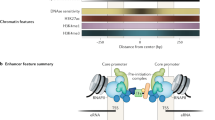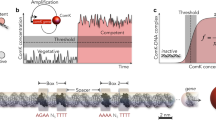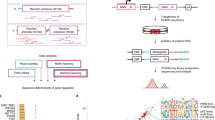Abstract
Selective gene transcription is mediated in part by regulatory proteins that bind to DNA response elements. These regulatory proteins receive global information from signal-transduction events. But transcriptional regulators may also be modified in an allosteric manner by response elements themselves to generate the pattern of regulation that is appropriate to an individual gene.
This is a preview of subscription content, access via your institution
Access options
Subscribe to this journal
Receive 51 print issues and online access
$199.00 per year
only $3.90 per issue
Buy this article
- Purchase on Springer Link
- Instant access to full article PDF
Prices may be subject to local taxes which are calculated during checkout


Similar content being viewed by others
References
Ptashne, M. How eukaryotic transcriptional activators work. Nature 335, 683–689 (1988).
Nguyen, J. T. & Lim, W. A. How Src exercises self-restraint. Nature Struct. Biol. 4, 256– 260 (1997).
Luo, X. & Sawadogo, M. Functional domains of the transcription factor USD2: atypical nuclear localization signals and context-dependent transcriptional activation domains. Mol. Cell. Biol. 16, 1367–1375 (1996).
Johansen, F. E. & Prywes, R. Identification of transcriptional activation and inhibitory domains in serum response factor (SRF) by using GAL4-SRF constructs. Mol. Cell. Biol. 13, 4640–4647 (1993).
Li, X. Y. & Green, M. R. Intramolecular inhibition of activating transcription factor-2 function by its DNA-binding domain. Genes Dev. 10, 517–527 ( 1996).
Brehm, A., Ohbo, K. & Schöler, H. The carboxy-terminal transactivation domain of Oct-4 acquires cell specificity through the POU domain. Mol. Cell. Biol. 17, 154–162 ( 1997).
Petersen, J. M. et al. Modulation of transcription factor Ets-1 DNA binding: DNA-induced unfolding of an alpha helix. Science 269, 1866–1869 (1995).
Meierhans, D. et al. DNA binding specificity of the basic-helix-loop-helix protein MASH-1. Biochemistry 34, 11026– 11036 (1995).
Weiss, M. A. et al. Folding transition in the DNA-binding domain of GCN4 on specific binding to DNA. Nature 347, 575– 578 (1990).
Shuman, J. D., Vinson, C. R. & McKnight, S. L. Evidence of changes in protease sensitivity and subunit exchange rate on DNA binding by C/EBP. Science 249, 771–774 (1990).
. Patel, L., Abate, C. & Curran, T. Altered protein conformation on DNA binding by Fos and Jun. Nature 347, 572–575 (1990).
Epstein, J. et al. Identification of a Pax paired domain recognition sequence and evidence for DNA-dependent conformational changes. J. Biol. Chem. 269, 8355–8361 ( 1994).
Ikeda, M. et al. Different DNA elements can modulate the conformation of thyroid hormone receptor heterodimer and its transcriptional activity. J. Biol. Chem. 271, 23096–23104 (1996).
. Tan, S. & Richmond, T. J. DNA binding-induced conformational change of the yeast transcriptional activator PRTF. Cell 62, 367–377 (1990).
Cleary, M. A., Pendergrast, S. & Herr, W. Structural flexibility in transcription complex formation revealed by protein-DNA photocrosslinking. Proc. Natl Acad. Sci. USA 94, 8450–8455 ( 1997).
Donaldson, L. W., Petersen, J. M., Graves, B. J. & McInrosh, L. P. Solution structure of the ETS domain from murine Ets-1: a winged helix-turn-helix DNA binding motif. EMBO J. 15, 125– 134 (1996).
. Werner, M. H. et al. The solution structure of the human ETS1-DNA complex reveals a noval mode of binding and true side chain intercalation. Cell 38, 761–771 ( 1995).
Jonsen, M. D., Petersen, J. M., Xu, Q. P. & Graves, B. J. Characterization of the cooperative function of inhibitory sequences in Ets-1. Mol. Cell. Biol. 16, 2065– 2073 (1996).
Skalicky, J. J., Donaldson, L. W., Petersen, J. M., Graves, B. J. & McIntosh, L. P. Structural coupling of the inhibitory regions flanking the ETS domain of murine Ets-1. Protein Sci. 5, 296–309 (1996).
. Miner, J. N. & Yamamoto, K. R. Regulatory crosstalk at composite response elements. Trends Biochem. Sci. 16, 426–426 (1991).
Wagner, S. & Green, M. R. DNA-binding domains: targets for viral and cellular regulatory. Curr. Opin. Cell Biol. 6, 410–441 (1994).
Martin, M. L., Lieberman, P. M. & Curran, T. Fos-Jun dimerization promotes interaction of the basic region with TFIIE-34 and TFIIF. Mol. Cell. Biol. 16 , 2110–2118 (1996).
. Eckner, R., Yao, T., Oldread, E. & Livingston, D. M. Interaction and functional collaboration of p300/CBP and bHLH proteins in muscle and B-cell differentiation. Genes Dev. 10, 2478– 2490 (1996).
Sartorelli, V. et al. Molecular mechanisms of myogenic coactivation by p300: direct interaction with the activation domain of MyoD and with the MADS box of MEF2C. Mol. Cell. Biol. 17, 1010– 1026 (1997).
Huang, C. C. & Herr, W. Differential control of transcription by homologous homeodomain coregulators. Mol. Cell. Biol. 16, 2967–2976 (1996).
. Misra, V. et al. Conformational alteration of Oct-1 upon DNA binding dictates selectivity in differential interactions with related transcriptional coactivators. Mol. Cell. Biol. 16, 4404– 4413 (1996).
Walker, S., Hayes, S. & O'Hare, P. Site-specific conformational alteration of the Oct-1 POU domain-DNA complex as the basis for differential recognition by Vmw65 (VP16). Cell 79, 841–852 (1994).
Johansen, F. E. & Prywes, R. Two pathways for serum regulation of the c-fos serum response element require specific sequence elements and a minimal domain of serum response factor. Mol. Cell. Biol. 14, 5920–5928 ( 1994).
. Hill, C. S., Wynne, J. & Treisman, R. Serum-regulated transcription by serum response factor (SRF): a novel role for the DNA binding domain. EMBO J. 13, 5421–5432 (1994).
Chen, J. D. & Evans, R. M. Atranscriptional co-repressor that interacts with nuclear hormone receptors. Nature 377 , 454–457 (1995).
Mangelsdorf, D. J. et al. Adirect repeat in the cellular retinol-binding protein type II gene confers differential regulation by RXR and RAR. Cell 66, 555–561 (1991).
. Kurokawa, R. et al. Polarity-specific activities of retinoic acid receptors determined by a co-repressor. Nature 377, 451– 454 (1995).
Kurokawa, R. et al. Regulation of retinoid signalling by receptor polarity and allosteric control of ligand binding. Nature 371, 528–531 (1994).
Saatcioglu, F., Deng, T. & Karin, M. Anovel cis element mediating ligand-independent activation by c-ErbA: implications for hormonal regulation. Cell 75, 1095– 1105 (1993).
. Rahman, A., Esmaili, A. & Saatcioglu, F. Aunique thyroid hormone response element in the human immunodeficiency virus type 1 long terminal repeat that overlaps the Sp1 binding sites. J. Biol. Chem. 207, 31059– 31064 (1995).
Tomie-Canie, M., Day, D., Samuela, H. H., Freedberg, I. M. & Blumenberg, M. Novel regulation of keratin gene expression by thyroid hormone and retinoid receptors. J. Biol. Chem. 271, 1416–1423 (1996).
Härd, T. et al. Solution structure of the glucocorticoid receptor DNA-binding domain. Science 249, 157– 160 (1990).
. Luisi, B. F. et al. Crystallographic analysis of the interaction of the glucocorticoid receptor with DNA. Nature 352, 497– 505 (1991).
Baumann, H. et al. Refined solution structure of the glucocorticoid receptor DNA-binding domain. Biochemistry 32, 13463 –13471 (1993).
van Tilborg, M. A. et al. Structure refinement of the glucocorticoid receptor-DNA binding domain from NMR data by relaxation matrix calculations. J. Mol. Biol. 247, 689–700 ( 1995).
. Schwabe, J. W. R. et al. The crystal structure of the estrogen receptor DNA-binding domain bound to DNA: how receptors discriminate between their response elements. Cell 75, 567–578 (1993).
Schwabe, J. W. et al. The oestrogen receptor recognizes an imperfectly palindromic response element through an alternative side-chain conformation. Structure 3, 201–213 ( 1995).
Dahlman-Wright, K. et al. Interaction of the glucocorticoid receptor DNA-binding domain with DNA as a dimer is mediated by a short segment of five amino acids. J. Biol. Chem. 266, 3107–3112 (1991).
. Drouin, J. et al. Homodimer formation is rate-limiting for high affinity DNA binding by glucocorticoid receptor. Mol. Endocrinol. 6, 1299–1309 (1992).
Yamamoto, K. R., Pearce, D., Thomas, J. & Miner, J. N. in Transcriptional Regulation (eds McKnight, S.L. & Yamamoto, K. R.) 1169– 1170 (Cold Spring Harbor Laboratory Press, NY, 1992 ).
Heck, S. et al. Adistinct modulating domain in glucocorticoid receptor monomers in the repression of activity of the transcription factor AP-1. EMBO J. 13, 4087–4095 ( 1994).
. Lefstin, J. A., Thomas, J. R. & Yamamoto, K. R. Influence of a steroid receptor DNA-binding domain on transcriptional regulatory functions. Genes Dev. 8, 2842–2856 (1994).
Cato, A. C. & Wade, E. Molecular mechanisms of anti-inflammatory action of glucocorticoids. Bioassays 18, 371–378 (1996).
Drouin, J. et al. Novel glucocorticoid receptor complex with DNA element of the hormone-repressed POMC gene. EMBO J. 12, 145–156 (1993).
. König, H., Ponta, H., Rahmsdorf, H. J. & Herrlich, P. Interference between pathway-specific transcription factors: glucocorticoids antagonize phorbol ester-induced AP-1 activity without altering AP-1 site occupation in vivo. EMBO J. 11, 2241 –2246 (1992).
Diamond, M. I. et al. Transcription factor interactions: selectors of positive or negative regulation from a single DNA element. Science 249, 1266–1271 (1990).
Jonat, C. et al. Antitumor promotion and antiinflammation: down-modulation of AP-1 (fos/jun) activity by glucocorticoid hormone. Cell 62, 1189–1204 (1990).
. Yang-yen, H.-F. et al. Transcriptional interference between c-Jun and the glucocorticoid receptor: mutual inhibition of DNA binding due to direct protein-protein interaction. Cell 62, 1205–1215 (1990).
Starr, D. B. et al. Intracellular receptors use a common mechanism to interpret signaling information at response elements. Genes Dev. 10, 1271–1283 (1996).
Saudek, V. et al. Solution structure of the basic region from the transcriptional activator GCN4. Biochemistry 30, 1310– 1317 (1991).
Ellenberger, T. E. et al. The GCN4 basic Áleucine zipper binds DNA as a dimer of uninterrupted alpha helices: crystal structure of the protein-DNA complex. Cell 71, 1223–1237 (1992).
O'Neil, K. T., Shuman, J. D., Ampe, C. & DeGrado, W. F. DNA-induced increase in the alpha-helical content of C/EBP and GCN4. Biochemistry 30, 9030–9034 ( 1991).
Krebs, D. et al. The basic subdomain of the c-Jun oncoprotein. A joint CD, Fourier-transform infrared and NMR study. Eur. J. Biochem. 231, 370–380 (1995).
. Ebneth, A. et al. Biophysical characterization of the c-Myb DNA-binding domain. Biochemistry 33, 14586– 14593 (1994).
Ogata, K. et al. The cavity in the hydrophobic core of Myb DNA-binding domain is reserved for DNA recognition and trans-activation. Nature Struct. Biol. 3, 178–187 ( 1996).
Jamin, N. et al. Secondary structure of the DNA-binding domain of the c-Myb oncoprotein in solution. A multidimensional double and triple heteronuclear NMR study. Eur. J. Biochem. 216, 147– 154 (1993).
. Carr, M. D. et al. Structure of the B-Myb DNA-binding domain in solution and evidence for multiple conformations in the region of repeat-2 involved in DNA binding: implications for sequence-specific DNA binding by Myb proteins. Eur. J. Biochem. 235, 721– 735 (1996).
Fujita, T., Nolan, G. P., Ghosh, S. & Baltimore, D. Independent modes of transcriptional activation by the p50 and p65 subunits of NF-kappa B. Genes Dev. 6, 775–787 (1992).
Hay, R. T. & Nicholson, J. DNA binding alters the protease susceptibility of the p50 subunit of NF-KappaB. Nucleic Acids Res. 21, 4592–4598 ( 1993).
. Matthews, J. R. et al. Conformational changes induced by DNA binding of NF-kappa B. Nucleic Acids Res. 23, 3393– 3402 (1995).
Toney, J. H. et al. Conformational changes in chicken thyroid hormone receptor alpha 1 induced by binding to ligand or to DNA. Biochemistry 32, 2–6 (1993).
Acknowledgements
We thank W. Herr, C. Jamieson, A. Johnson, E. Levine, D. B. Starr and J. Weissman for comments on the manuscript. The authors are supported by grants from the NIH and the NSF.
Author information
Authors and Affiliations
Rights and permissions
About this article
Cite this article
Lefstin, J., Yamamoto, K. Allosteric effects of DNA on transcriptional regulators. Nature 392, 885–888 (1998). https://doi.org/10.1038/31860
Issue Date:
DOI: https://doi.org/10.1038/31860
This article is cited by
-
NMP4, an Arbiter of Bone Cell Secretory Capacity and Regulator of Skeletal Response to PTH Therapy
Calcified Tissue International (2023)
-
Advances of Predicting Allosteric Mechanisms Through Protein Contact in New Technologies and Their Application
Molecular Biotechnology (2023)
-
Identification of dicyclohexyl phthalate as a glucocorticoid receptor antagonist by molecular docking and multiple in vitro methods
Molecular Biology Reports (2021)
-
Modeling the allosteric modulation on a G-Protein Coupled Receptor: the case of M2 muscarinic Acetylcholine Receptor in complex with LY211960
Scientific Reports (2020)
-
HDX reveals the conformational dynamics of DNA sequence specific VDR co-activator interactions
Nature Communications (2017)
Comments
By submitting a comment you agree to abide by our Terms and Community Guidelines. If you find something abusive or that does not comply with our terms or guidelines please flag it as inappropriate.



